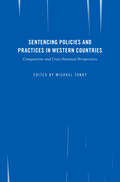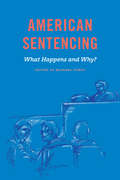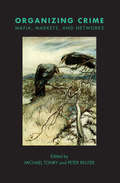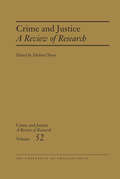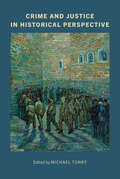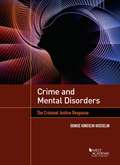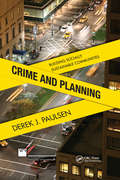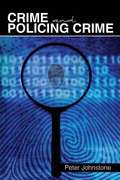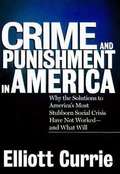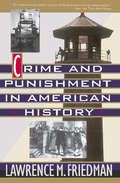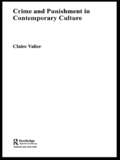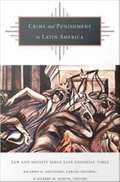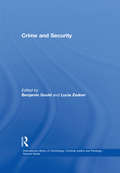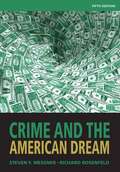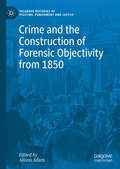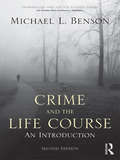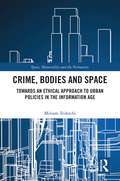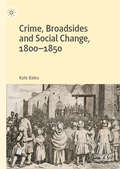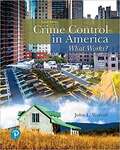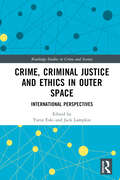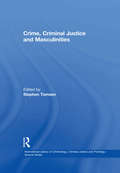- Table View
- List View
Crime and Justice, Volume 42: Crime and Justice in America: 1975-2025 (Crime and Justice: A Review of Research #42)
by The University of Chicago PressFor thirty-five years, the Crime and Justice series has provided a platform for the work of sociologists, psychologists, criminal lawyers, justice scholars, and political scientists as it explores the full range of issues concerning crime, its causes, and it remedies. For the American criminal justice system, 1975 was a watershed year. Offender rehabilitation and individualized sentencing fell from favor and the partisan politics of “law and order” took over. Policymakers’ interest in science declined just as scientific work on crime, recidivism, and the justice system began to blossom. Some policy areas—in particular, sentencing, gun violence, drugs, and youth violence—became evidence-free zones. Crime and Justice in America: 1975-2025 tells the complicated relationship between policy and knowledge during this crucial time and charts prospects for the future. The contributors to this volume, the leading scholars in their fields, bring unsurpassed breadth and depth of knowledge to bear in answering these questions. They include Philip J. Cook, Francis T. Cullen, Jeffrey Fagan, David Farrington, Daniel S. Nagin, Peter Reuter, Lawrence W. Sherman, and Franklin E. Zimring.
Crime and Justice, Volume 42
by Michael TonryFor the American criminal justice system, 1975 was a watershed year. Offender rehabilitation and individualized sentencing fell from favor. The partisan politics of "law and order" took over. Among the results four decades later are the world's harshest punishments and highest imprisonment rate. Policymakers' interest in what science could tell them plummeted just when scientific work on crime, recidivism, and the justice system began to blossom. Some policy areas--sentencing, gun violence, drugs, youth violence--became evidence-free zones. In others--developmental crime prevention, policing, recidivism studies, evidence mattered. Crime and Justice in America: 1975-2025 tells how policy and knowledge did and did not interact over time and charts prospects for the future. What accounts for the timing of particular issues and research advances? What did science learn or reveal about crime and justice, and how did that knowledge influence policy? Where are we now, and, perhaps even more important, where are we going? The contributors to this volume, the leading scholars in their fields, bring unsurpassed breadth and depth of knowledge to bear in answering these questions. They include Philip J. Cook, Francis T. Cullen, Jeffrey Fagan, David Farrington, Daniel S. Nagin, Peter Reuter, Lawrence W. Sherman, and Franklin E. Zimring. For thirty-five years, the Crime and Justice series has provided a platform for the work of sociologists, psychologists, criminal lawyers, justice scholars, and political scientists as it explores the full range of issues concerning crime, its causes, and it remedies.
Crime and Justice, Volume 45: Sentencing Policies and Practices in Western Countries: Comparative and Cross-National Perspectives (Crime and Justice: A Review of Research #45)
by The University of Chicago PressSentencing Policies and Practices in Western Countries: Comparative and Cross-national Perspectives is the forty-fifth addition to the Crime and Justice series. Contributors include Thomas Weigend on criminal sentencing in Germany since 2000; Julian V. Roberts and Andrew Ashworth on the evolution of sentencing policy and practice in England and Wales from 2003 to 2015; Jacqueline Hodgson and Laurène Soubise on understanding the sentencing process in France; Anthony N. Doob and Cheryl Marie Webster on Canadian sentencing policy in the twenty-first century; Arie Freiberg on Australian sentencing policies and practices; Krzysztof Krajewski on sentencing in Poland; Alessandro Corda on Italian policies; Michael Tonry on American sentencing; and Tapio Lappi-Seppälä on penal policy and sentencing in the Nordic countries.
Crime and Justice, Volume 46: Reinventing American Criminal Justice (Crime and Justice: A Review of Research #46)
by The University of Chicago PressJustice Futures: Reinventing American Criminal Justice is the forty-sixth volume in the Crime and Justice series. Contributors include Francis Cullen and Daniel Mears on community corrections; Peter Reuter and Jonathan Caulkins on drug abuse policy; Harold Pollack on drug treatment; David Hemenway on guns and violence; Edward Mulvey on mental health and crime; Edward Rhine, Joan Petersilia, and Kevin Reitz on parole policies; Daniel Nagin and Cynthia Lum on policing; Craig Haney on prisons and incarceration; Ronald Wright on prosecution; and Michael Tonry on sentencing policies.
Crime and Justice, Volume 47: A Review of Research (Crime and Justice: A Review of Research #47)
by The University of Chicago PressSince 1979, the Crime and Justice series has presented a review of the latest international research, providing expertise to enhance the work of sociologists, psychologists, criminal lawyers, justice scholars, and political scientists. The series explores a full range of issues concerning crime, its causes, and its cures. In both the review and the thematic volumes, Crime and Justice offers an interdisciplinary approach to address core issues in criminology. Volume 47 will be a review volume featuring, among other selections, a top-of-class impact ranking.
Crime and Justice, Volume 48: American Sentencing (Crime and Justice: A Review of Research #48)
by The University of Chicago PressAmerican Sentencing provides an up-to-date and comprehensive overview of efforts in the state and the federal systems to make sentencing fairer, reduce overuse of imprisonment, and help offenders live law-abiding lives. It addresses a variety of topics and themes related to sentencing and reform, including racial disparities, violence prediction, plea negotiation, case processing, federal and state guidelines, California’s historic “realignment,” and more. This volume covers what students, scholars, practitioners, and policy makers need to know about how sentencing really works, what a half century’s “reforms” have and have not accomplished, how sentencing processes can be made fairer, and how sentencing outcomes can be made more just. Its writers are among America’s leading scholarly specialists—often the leading specialist—in their fields. Clearly and accessibly written, American Sentencing is ideal for teaching use in seminars and courses on sentencing, courts, and criminal justice. Its authors’ diverse perspectives shed light on these issues, making it likely the single, most authoritative source of information on the state of sentencing in America today.
Crime and Justice, Volume 49: Organizing Crime: Mafias, Markets, and Networks (Crime and Justice: A Review of Research)
by The University of Chicago PressFor most Americans, The Godfather, The Sopranos, and the Cosa Nostra exemplify organized crime. In Asia the term conjures up images of Japanese yakuza and Chinese triads, in Italy the Cosa Nostra and ‘Ndrangheta, in Latin America Mexican narco-gangs and Colombian drug cartels, in the Netherlands transnational drug and human trafficking, and in Scandinavia outlaw motorcycle gangs. Some but not all those organizations are “mafias” with centuries-long histories, distinctive cultures, and complicated relationships with local communities and governments. Others are new, large but transitory and with no purpose other than maximizing profits from illegal markets. Organized crime organizations have existed for centuries. Serious scholarly, as opposed to journalistic or law enforcement, efforts to understand them, however, date back only a few decades. Authoritative overviews were, until very recently, impossible. Rigorous, analytically acute, and methodologically sophisticated literatures did not exist. They have begun to emerge. They have developed in many countries, involve work in different languages and disciplines, and deploy a wide range of methods. Organizing Crime: Mafias, Markets, and Networks provides the most exhaustive overview ever published of knowledge about organized crime. It provides intensive accounts of American, Italian, and Dutch developments, covers both national mafias and transnational criminality, and delves in depth into gender, human capital, and money laundering issues. The writers are based in seven countries. To a person they are, or are among, the world’s most distinguished specialists in their subjects. At last, credible explanations and testable hypotheses are available concerning when, why, and under what circumstances mafias and other organized crime organizations come into being, what makes them distinctive, what they do and with what effects, and how to contain them.
Crime and Justice, Volume 52: A Review of Research (Crime and Justice: A Review of Research #52)
by The University of Chicago PressVolume 52 is an annual survey of cutting-edge issues by preeminent criminology scholars. Since 1979, Crime and Justice has presented a review of the latest international research, providing expertise to enhance the work of sociologists, psychologists, criminal lawyers, justice scholars, and political scientists. The series explores a full range of issues concerning crime, its causes, and its cures. In both the review and the thematic volumes, Crime and Justice offers an interdisciplinary approach to address core issues in criminology.
Crime and Justice, Volume 53: Crime and Justice in Historical Perspective (Crime and Justice: A Review of Research #53)
by The University of Chicago PressPresents cutting-edge scholarship by preeminent criminology scholars. Since 1979, Crime and Justice has presented a review of the latest international research, providing expertise to enhance the work of sociologists, psychologists, criminal lawyers, justice scholars, and political scientists. The series explores a full range of issues concerning crime, its causes, and its cures. In both the review and the thematic volumes, Crime and Justice offers an interdisciplinary approach to address core issues in criminology.
Crime And Mental Disorders: The Criminal Justice Response (Higher Education Coursebook)
by Denise Gosselin<p>The newest entry in the cutting edge topic of Mental Illness and Crime, this book from Denise Gosselin is practically focused and straightforward in its approach. It's clear, concise writing style avoids jargon and will engage both undergraduate and graduate students. It includes discussions of understanding mental illness, the changing landscape of criminal justice and mental illness, criminal justice responses to mental illness, alternatives to incarceration and global issues. An accompanying website includes Test Banks and other instructional materials. <p>Organized into five sections: <p> <li>Part I UNDERSTANDING MENTAL ILLNESS concern the history (past and present), classifications, and introduction to the criminal justice issues on the responses to people with mental illness. <li>Part II THE CHANGING LANDSCAPE examines the criminal justice involved encounters that occur outside of the traditional system, involving intervention, collaboration, and civil commitment. <li>Part III CRIMINAL JUSTICE RESPONSES look at law and policy of law enforcement, the criminal court and corrections. <li>Part IV ALTERNATIVES TO INCARCERATION reflects recent changes to reentry and community corrections. The juvenile justice component includes the brief system responses to juveniles with mental disorders. <li>Part V GLOBAL ISSUES stands alone as chapter 14 to remind us that we are not alone! The issues and system responses are not unique to the United States. </li> </p>
Crime and Planning: Building Socially Sustainable Communities
by Ph.D., Derek PaulsenThe form and layout of a built environment has a significant influence on crime by creating opportunities for it and, in turn, shaping community crime patterns. Effective urban planners and designers will consider crime when making planning and design decisions. A co-publication with the American Planning Association, Crime and Planning:
Crime And Policing Crime
by Peter JohnstoneCrime and Policing Crime covers four types of crime: assaults, missing persons, theft offences, and drug offences. It also covers the different types of police officers, such as municipal police, state law enforcement, and federal and international agencies. <p><p> Taking students back in time, Crime and Policing Crime cover how pioneers in areas of science have helped police officers to solve crimes and identify suspects.
Crime and Punishment in America
by Elliott CurrieThere are five times as many Americans behind bars today as in 1970. The national incarceration rate in 1997 was twice that in 1985. California's prison system has become the third largest in the world.
Crime And Punishment In American History
by Lawrence FriedmanIn a panoramic history of our criminal justice system from Colonial times to today, one of our foremost legal thinkers shows how America fashioned a system of crime and punishment in its own image.
Crime and Punishment in Contemporary Culture (International Library of Sociology)
by Claire ValierToday, questions about how and why societies punish are deeply emotive and hotly contested. In Crime and Punishment in Contemporary Culture, Claire Valier argues that criminal justice is a key site for the negotiation of new collective identities and modes of belonging. Exploring both popular cultural forms and changes in crime policies and criminal law, Valier elaborates new forms of critical engagement with the politics of crime and punishment. In doing so, the book discusses:· Teletechnologies, punishment and new collectivities· The cultural politics of victims rights· Discourses on foreigners, crime and diaspora· Terror, the death penalty and the spectacle of violence.Crime and Punishment in Contemporary Culture makes a timely and important contribution to debate on the possibilities of justice in the media age.
Crime and Punishment in Latin America: Law and Society since Late Colonial Times
by Ricardo D. Salvatore Carlos Aguirre Gilbert M. JosephCrowning a decade of innovative efforts in the historical study of law and legal phenomena in the region, Crime and Punishment in Latin America offers a collection of essays that deal with the multiple aspects of the relationship between ordinary people and the law. Building on a variety of methodological and theoretical trends--cultural history, subaltern studies, new political history, and others--the contributors share the conviction that law and legal phenomena are crucial elements in the formation and functioning of modern Latin American societies and, as such, need to be brought to the forefront of scholarly debates about the region's past and present. While disassociating law from a strictly legalist approach, the volume showcases a number of highly original studies on topics such as the role of law in processes of state formation and social and political conflict, the resonance between legal and cultural phenomena, and the contested nature of law-enforcing discourses and practices. Treating law as an ambiguous and malleable arena of struggle, the contributors to this volume--scholars from North and Latin America who represent the new wave in legal history that has emerged in recent years-- demonstrate that law not only produces and reformulates culture, but also shapes and is shaped by larger processes of political, social, economic, and cultural change. In addition, they offer valuable insights about the ways in which legal systems and cultures in Latin America compare to those in England, Western Europe, and the United States. This volume will appeal to scholars in Latin American studies and to those interested in the social, cultural, and comparative history of law and legal phenomena. Contributors. Carlos Aguirre, Dain Borges, Lila Caimari, Arlene J. Daz, Luis A. Gonzalez, Donna J. Guy, Douglas Hay, Gilbert M. Joseph, Juan Manuel Palacio, Diana Paton, Pablo Piccato, Cristina Rivera Garza, Kristin Ruggiero, Ricardo D. Salvatore, Charles F. Walker
Crime and Security (International Library Of Criminology, Criminal Justice And Penology - Second Ser.)
by Benjamin Goold Lucia ZednerThe pursuit of security is now central to the development of public policy and a driving force behind the spread of private policing. Just as new theoretical frameworks are needed to deal with the increasing tendency of crime control policies to focus on risk reduction, new forms of governance are also required to deal with the rapid growth of the private security industry. This volume brings together a wide range of contributions from leading scholars in the field and includes international and comparative perspectives on the challenges posed by the rise of the 'security society'.
Crime and the American Dream
by Steven F. Messner Richard RosenfeldHow has America's over-emphasis on the pursuit of materialistic gain contributed to the it's high rate of violent crime? CRIME AND THE AMERICAN DREAM, 5th Edition is an easy-to-understand book that attempts to answer that question using seminal criminological theory.
Crime and the Construction of Forensic Objectivity from 1850: Space, Media, Experts And Ethics (Palgrave Histories of Policing, Punishment and Justice)
by Alison AdamThis book charts the historical development of 'forensic objectivity' through an analysis of the ways in which objective knowledge of crimes, crime scenes, crime materials and criminals is achieved. Taking an interdisciplinary approach, with authors drawn from law, history, sociology and science and technology studies, this work shows how forensic objectivity is constructed through detailed crime history case studies, mainly in relation to murder, set in Scotland, England, Germany, Sweden, USA and Ireland. Starting from the mid-nineteenth century and continuing to the present day, the book argues that a number of developments were crucial. These include: the beginning of crime photography, the use of diagrams and models specially constructed for the courtroom so jurors could be ‘virtual witnesses’, probabilistic models of certainty, the professionalization of medical and scientific expert witnesses and their networks, ways of measuring, recording and developing criminal records and the role of the media, particularly newspapers in reporting on crime, criminals and legal proceedings and their part in the shaping of public opinion on crime. This essential title demonstrates the ways in which forensic objectivity has become a central concept in relation to criminal justice over a period spanning 170 years.
Crime and the Life Course
by Michael BensonIn recent years, the lifecourse perspective has become a popular theoretical orientation toward crime. Yet despite its growing importance in the field of criminology, most textbooks give it only cursory treatment. Crime and the Lifecourse: An Introduction by Michael L. Benson provides a comprehensive overview of contemporary research and theory on the life-course approach to crime. The book emphasizes a conceptual understanding of this approach. A special feature is the integration of qualitative and quantitative research on criminal life histories. This book: provides an overview of the life course approach and describes the major concepts and issues in lifecourse theory as it applies to criminology reviews evidence on biological and genetic influences on crime reviews research on the role of the family in crime and juvenile delinquency provides a detailed discussion of the criminological lifecourse theories of Moffitt, Hagan, Sampson and Laub, and others discusses the connections between youthful crime and adult outcomes in education, occupation, and marriage presents an application of the lifecourse approach to white-collar crime discusses how macro sociological and historical developments have influenced the shape of the lifecourse in American society as it relates to patterns in crime.
Crime, Bodies and Space: Towards an Ethical Approach to Urban Policies in the Information Age
by Miriam TedeschiWith cities increasingly following rigid rules for designing out crime and producing spaces under surveillance, this book asks how information shapes bodies, space, and, ultimately, policymaking. In recent years, public spaces have changed in Western countries, with the urban realm becoming an ever-more monitored, privatised, homogeneous, and aseptic space that has lost its character, uniqueness, and diversity in the name of ‘security’. This underpins precise moral and political choices in terms of what a space should be, how it can be used, and by whom. These choices generate material consequences concerning urban inequality and freedom, or otherwise, of movement. Based on ethnographic and autoethnographic explorations in London’s ‘criminal’ spaces, this book illustrates how rules, policies, and moral values, far from being abstract concepts, are in fact material. Outlining the basis of a new urban information ethics, the book both exposes and challenges how moral values and predefined categories are applied to, and materially shape, the movement of bodies in urban space with regard to crime and security policies. Drawing on Gilbert Simondon’s information theory and a wide range of work in urban studies, geography, and planning, as well as in surveillance studies, object-oriented ontology, and contemporary theoretical work on both materiality and affect, the book provides a radically new perspective on urban space in general, and crime and security in particular. This book uses a balanced mix of theoretical concepts and empirical study to bring theory and practice together in an intertwining of ethnography and autoethnography.This book will be of interest to students and scholars in the fields of urban studies, urban geography, sociology, surveillance studies, legal theory, socio-legal studies, planning law, environmental law, and land law.
Crime, Broadsides and Social Change, 1800-1850
by Kate BatesThis book explores the form, function and meaning of crime and execution broadsides printed in nineteenth-century Britain. By presenting a detailed discourse analysis of 650 broadsides printed across Britain between the years 1800-1850, this book provides a unique and alternative interpretation as to their narratives of crime. This criminological interpretation is based upon the social theories of Emile Durkheim, who recognised the higher utility of crime and punishment as being one of social integration and the preservation of moral boundaries. The central aim of this book is to show that broadsides relating to crime and punishment served as a form of moral communication for the masses and that they are examples of how the working class once attempted to bolster a sense of stability and community, during the transitional years of the early nineteenth century, by effectively representing both a consolidation and celebration of their core values and beliefs.
Crime Control in America: What Works? (What's New in Criminal Justice)
by John WorrallFor courses in crime prevention, introduction to criminal justice, and criminal justice policy. <p><p> Crime Control in America: What Works? provides comprehensive coverage of what works in policing, prosecution, courts, and legislative methods of crime control. It also moves beyond the justice system and examines the effectiveness of crime control at the individual, family, school, and community levels. Finally, it covers environmental criminology and explanations of large-scale crime trends. <p><p> The 4th edition includes new sections covering the most current and controversial topics in crime control, including the alleged Ferguson effect, immigration enforcement, raising the age of majority, and mass shootings.
Crime, Criminal Justice and Ethics in Outer Space: International Perspectives (Routledge Studies in Crime and Society)
by Yarin EskiBreaking new ground in criminology, this book reflects on the expansion of outer space endeavours, the new pathways this presents for crime, challenges to Earth-based conceptions of justice, and the ethical issues raised.This book is the first edited collection of chapters focused on how to prepare for, address and respond to, instances of criminal and harmful behaviour in (and related to) outer space. It also considers what criminal justice might look like in outer space, and how the important arena of ethics might play a pivotal role in helping overcome problems related to crime and crime control. The book comprises 24 chapters from authors spanning six continents, giving a truly international dimension to the first anthology relating to the intersection of space criminology, space criminal justice and space ethics. It is this international dimension that is essential to the development of a holistic understanding of crime, criminal justice and ethics in outer space.Exploring recent topics, including the dark origin of space exploration, expansion of satellite industries, space tourism, asteroid mining and human settlement on the Moon and Mars, the book will appeal to space professionals, and students and researchers working in criminology, critical security studies, law, and ethics.
Crime, Criminal Justice and Masculinities (International Library Of Criminology, Criminal Justice And Penology - Second Ser.)
by Stephen TomsenThis volume features the leading contemporary articles that are part of, or related to, the 'new masculinities' approach in this sphere. These comprise an impressive range of theoretical and empirical work including important cultural and ethnographic analyses. They emphasise the relationship between masculinities, the causes and patterns of most criminal offending and victimisation and the broader workings of the wider criminal justice system of policing (public and private), criminal courts, corrections and prisons. All of the material has been selected from flagship international journals and was produced by a global mix of male and female researchers with diverse disciplinary backgrounds. These scholars share the view that masculinities are plural, socially constructed, reproduced in the collective social practices of different men and embedded in institutional and occupational settings. Furthermore, masculinities are intricately linked with social struggles for power that occur between men and women and different men. Crime, criminal justice and their cultural representation are key terrain for these masculine contests and are always overlain with issues such as social class, age, race/ethnicity and sexuality.

